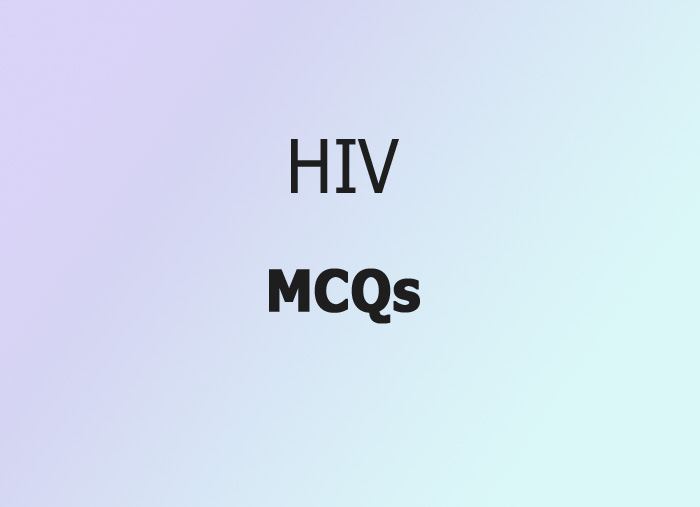- NEED HELP? CALL US NOW
- +919995411505
- [email protected]

1. In individuals with HIV, opportunistic infections are:
a. More frequent
b. Less frequent
c. Non-existent
d. None of the above
2. HIV is a _____
a. Lentivirus
b. Capripoxvirus
c. Gallivirus
d. 3Papillomavirus
3. the most common cause of inpatient admission to hospital for those living with HIV is ______.
a. tuberculosis and other mycobacterial infections
b. cardiovascular disorders
c. bacterial infections
d. none of these
4. Which cells are destroyed by HIV?
a) A- helper cells
b) K-helper cells
c) T-helper cells
d) Y-helper cells
5. Which is the second most common way of spreading HIV?
a) Sexual intercourse with HIV infected
b) sharing needles
c) Sharing food
d) from infected mother to child
6. How many stages are there in HIV infection?
a) One
b) Two
c) Three
d) Four
7. To which of the following disease HIV virus leads to?
a) Cancer
b) Brain tumour
c) AIDS
d) Hepatitis
8. Which of the following is associated with HIV?
a) Hairy leukoplakia
b) Erythroplakia
c) Oral lichen planus
d) Bullous pemphigoid
9. the most common reported oral malignancy in HIV infection?
a) Squamous cell carcinoma
b) Verccous carcinoma
c) Multiple myeloma
d)Kaposi sarcoma
10. Which of the following would be seen in late HIV cases?
a) Kaposi sarcoma
b) Oral hairy leukoplakia
c) Periodontitis
d) All of the above
Answer with explanation
1. A
2. A
The human immunodeficiency viruses (HIV) are two species of Lentivirus (a subgroup of retrovirus) that infect humans
3. A
4. C
HIV attacks the immune system, specially the CD4 cells, often called T-helper cells and makes copies inside these cells. As HIV destroys more CD4 cells and makes more copies of itself, it gradually breaks down a person’s immune system.
5. B
Sharing needles is the second most common way that HIV is spreading. Sexual intercourse with HIV infected is the most common way of HIV spreading. Any person who shares needles with someone who is HIV positive is at risk for HIV.
6. C
There are three stages of HIV infection those are, a) acute HIV infection, b) clinical latency, and c) acquired immunodeficiency syndrome (AIDS). People living with HIV may progress through these stages at different rates, depending on a variety of factors including their genetic makeup.
7. C
HIV is the virus that leads to AIDS. People can have HIV for years without having AIDS. Being infected with HIV does not mean suffering from AIDS. People with HIV who start treatment early in their infection, stay on treatment can prevent the disease from progressing to AIDS.
8. A
| Classification of AIDS | |
| Class I | Primary infection Fever, Athralgia, myalgia Primary infection occurs 2-4 weeks after exposure. Appearance of specific Anti-HIV antibodies in serum ( sero conversion) takes places later at 3-12 weeks ( median 8 weeks) |
| Class II | Asymptomatic infection |
| Class III | Persistent generalized lymphadenopathy.it is defined as enlarged glands at > 2 extra inguinal sites. |
| Class IV | AIDS Syndrome Characterized by specific opportunistic infections tumours etc. Infections ( Bacterial, Viral and fungi) Candidiasis ( most common) Pneumocystis carinii pneumonia Mycobacterium avium intracellular infection Herpex simplex Toxoplasmosis Molluscum contagiosum Tumors Kaposi sarcoma Non-Hogdgkins lymphoma Oral hairy leukoplakia |
9. D
Refer answer from the above table
10. D
Refer answer from the above table




